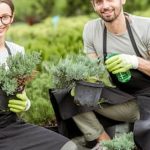Are you looking to start your own vegetable garden but don’t have the space for a traditional in-ground garden? Look no further. Get your hands on a free ebook on container vegetable gardening and learn how to grow your favorite vegetables in limited space.
Container gardening is an innovative solution for urban dwellers, apartment renters, and anyone with limited outdoor space. In this comprehensive guide, we’ll explore the numerous benefits of container gardening for vegetable plants, the best vegetables to grow in containers, and provide you with a step-by-step guide to setting up your very own container garden.
Whether you’re a beginner or an experienced gardener, this free ebook will offer invaluable tips for maintaining and caring for your container vegetable plants. We’ll also highlight common mistakes to avoid and share inspiring success stories from fellow container vegetable gardeners. So don’t miss out on this incredible resource that’s sure to revolutionize urban gardening.
Benefits of Container Gardening for Vegetable Plants
Container gardening offers several benefits for vegetable plants compared to traditional in-ground gardening. One of the main advantages is the ability to control the environment in which your plants grow. This means you can place your containers in the optimal sunlight, shade, or sheltered area to promote healthy growth. Additionally, container gardening allows for better soil quality and drainage, as you can select specific soil types and add drainage materials to ensure proper water flow.
Space-Saving Solution
For urban dwellers or those with limited outdoor space, container gardening provides a space-saving solution for growing vegetables. Whether you have a balcony, patio, or even just a windowsill, there’s always room for a few containers of vegetable plants. This accessibility makes it easier for individuals living in apartments or condos to enjoy the benefits of homegrown produce.
Pest and Disease Management
Another benefit of container gardening is the reduced risk of pests and diseases affecting your vegetable plants. By keeping your plants off the ground and in isolated containers, you can minimize contact with soil-borne pests and diseases that commonly impact in-ground gardens. This reduces the need for chemical pesticides and fungicides, making container gardening a more eco-friendly option.
Improved Accessibility
Container vegetable gardening also offers improved accessibility for gardeners with physical limitations. With raised containers, individuals who have difficulty bending or kneeling can still enjoy tending to their plants without putting strain on their bodies. This inclusivity makes it possible for more people to take part in growing their own fresh vegetables at home.
Best Vegetables for Container Gardening
Container gardening is a great option for gardeners who have limited space or want to have more control over their vegetable plants. When it comes to choosing the best vegetables for container gardening, there are a few factors to consider. First, you’ll want to select vegetables that don’t require a lot of space to grow. This means focusing on smaller varieties or ones that can be easily trained to grow vertically.
Some of the best vegetables for container gardening include tomatoes, peppers, lettuce, spinach, radishes, green onions, and herbs like basil and cilantro. These types of vegetables and herbs thrive in containers and don’t need a lot of room to spread out their roots. Plus, they can also be easily harvested when grown in containers.
When selecting the best vegetables for your container garden, it’s important to consider the amount of sunlight your space receives. Most vegetable plants require at least 6-8 hours of direct sunlight per day. Additionally, make sure to choose high-quality potting soil specifically formulated for container gardening to ensure your vegetables have the necessary nutrients and drainage they need to thrive.
For an in-depth guide on the best vegetables for container gardening and how to care for them properly, be sure to check out our free ebook on container vegetable gardening. This comprehensive resource will provide you with all the information you need to successfully grow a thriving container vegetable garden right at home.
Whether you’re new to gardening or looking for ways to maximize your limited gardening space, this free ebook is a valuable resource for any urban gardener.
Step-by-Step Guide to Setting Up a Container Vegetable Garden
Setting up a container vegetable garden is a great way to grow your own produce and enjoy the benefits of gardening, even if you have limited space. With the right tools and knowledge, anyone can successfully set up a thriving container vegetable garden. In this section, we will provide you with a step-by-step guide to help you get started.
Choosing the Right Containers
The first step in setting up a container vegetable garden is choosing the right containers for your plants. You’ll want to select containers that are large enough to accommodate the root systems of your chosen vegetables and have proper drainage holes. Consider using pots, window boxes, or even repurposed items like buckets or barrels.
Selecting the Perfect Location
Once you’ve chosen your containers, it’s time to select the perfect location for your container garden. Most vegetable plants require at least 6-8 hours of sunlight each day, so choose a spot on your balcony, patio, or windowsill that receives adequate sunlight. Keep in mind that some vegetables may require more or less sun, so be sure to research the specific needs of each plant.
Preparing the Soil and Planting
Next, it’s time to prepare the soil for planting. Choose a high-quality potting mix that is well-draining but also retains moisture. Fill your containers with the potting mix and then plant your chosen vegetable seeds or seedlings according to their specific spacing requirements. Be sure to label each container so you know what’s growing where.
By following these simple steps, you can set up a successful container vegetable garden and start enjoying homegrown produce in no time. For more in-depth information on setting up a container vegetable garden, be sure to download our free ebook on container vegetable gardening.
Tips for Maintaining and Caring for Container Vegetable Plants
Container vegetable gardening is a great way to grow your own produce, even if you don’t have access to a traditional garden plot. Once you’ve set up your container garden and chosen the best vegetables for your space, it’s important to know how to properly care for and maintain your plants. With the right attention and care, your container vegetable garden can flourish and provide you with a bountiful harvest.
One key aspect of maintaining and caring for container vegetable plants is watering. Container gardens require more frequent watering than traditional gardens because the soil in containers tends to dry out quickly. It’s essential to check the moisture level of the soil regularly and water as needed. Overwatering can lead to root rot, so it’s important to find the right balance.
In addition to watering, fertilizing is also crucial for the health and growth of your container vegetable plants. Since the nutrients in potting soil can be depleted over time, it’s important to fertilize your plants regularly. Consider using a slow-release fertilizer or organic compost to provide essential nutrients to your plants throughout the growing season. For more detailed tips on maintaining and caring for container vegetable plants, be sure to download our free ebook on container vegetable gardening.
Common Mistakes to Avoid in Container Vegetable Gardening
Container vegetable gardening can be a highly rewarding and efficient way to grow your own produce, but there are several common mistakes that many beginners make. By learning about these mistakes and how to avoid them, you can set yourself up for success and enjoy a bountiful harvest from your container garden.
Here are some common mistakes to avoid in container vegetable gardening:
1. Choosing the wrong containers: One of the biggest mistakes people make in container gardening is choosing the wrong type or size of container for their vegetables. Some plants need deeper pots while others require wider ones. Be sure to research the specific needs of each vegetable you plan to grow.
2. Over or under-watering: Finding the right balance when it comes to watering your container plants is crucial. Overwatering can lead to root rot, while underwatering can result in stunted growth and poor fruit production. Consider investing in a moisture meter to keep track of your plants’ watering needs.
3. Using poor quality soil: The type of soil you use in your containers can make all the difference in the health and performance of your vegetable plants. Choose a high-quality potting mix that provides good drainage and contains essential nutrients for healthy plant growth.
By being mindful of these common mistakes, you can create a thriving container vegetable garden that yields an abundant harvest for you and your family. For more detailed information on how to successfully avoid these mistakes, be sure to download our free ebook on container vegetable gardening today.
Free Ebook on Container Vegetable Gardening
Are you looking to start your container vegetable garden but don’t know where to begin? Look no further. Our free ebook on container vegetable gardening is here to help you kickstart your gardening journey. In this comprehensive guide, you can expect to find everything you need to know about starting and maintaining a thriving container vegetable garden right at your fingertips.
What can you expect from our free ebook on container vegetable gardening? Here’s a sneak peek:
- A detailed introduction to the concept of container vegetable gardening, including its benefits and why it’s an ideal option for urban gardeners
- A comprehensive list of the best vegetables for container gardening, complete with tips on how to care for each plant
- A step-by-step guide to setting up your own container vegetable garden, from choosing the right containers to selecting the perfect potting soil
- Useful tips and tricks for maintaining and caring for your container vegetable plants throughout the growing season
And that’s just the beginning. Our free ebook on container vegetable gardening is jam-packed with valuable information, expert advice, and practical tips that will set you up for success in your new gardening venture.
Whether you’re a beginner looking to dip your toes into the world of gardening or an experienced gardener interested in exploring container gardening, our free ebook is the perfect resource for you. So get ready to transform your living space into a flourishing green oasis with our free ebook on container vegetable gardening.
Where to Get Your Free Ebook on Container Vegetable Gardening
If you are interested in learning more about container vegetable gardening, there are plenty of resources available to help guide you through the process. One great option is to get your hands on a free ebook on container vegetable gardening. These ebooks can provide valuable information and tips for beginners and experienced gardeners alike.
There are several ways to obtain a free ebook on container vegetable gardening. One option is to visit gardening websites or blogs that offer free downloadable ebooks as part of their content. Another option is to sign up for newsletters from gardening experts or organizations, as they often provide free ebooks as a way to share valuable information with their audience.
In addition, you may also find free ebooks on container vegetable gardening available through online platforms such as Amazon Kindle, Apple Books, or Google Play Books. These platforms often feature free or discounted ebooks on various topics, including gardening. By searching for “container vegetable gardening” in the ebook section of these platforms, you may be able to find a free resource to add to your digital library.
Overall, obtaining a free ebook on container vegetable gardening can be a convenient and cost-effective way to access helpful tips and advice for creating and maintaining your own successful container garden. Whether you are new to gardening or looking to expand your knowledge, a free ebook can serve as a valuable tool in helping you achieve the best results with your container vegetable plants.
Success Stories From Container Vegetable Gardeners
Many urban gardeners have found success in container vegetable gardening, and their stories can be an inspiration for beginners. One such success story comes from Sarah, a city dweller with limited outdoor space.
She started her container vegetable garden on her small balcony, and within a few months, she was enjoying fresh tomatoes, peppers, and herbs right from her own home. Sarah’s success demonstrates that even those with minimal space can still enjoy the rewards of growing their own vegetables.
Another success story comes from Mark, who decided to try his hand at container gardening after reading a free ebook on container vegetable gardening. With the help of the ebook’s valuable tips and advice, Mark was able to set up a thriving vegetable garden on his rooftop.
He now enjoys a bountiful harvest of lettuce, carrots, and radishes throughout the growing season. Mark’s experience shows that with the right resources and knowledge, anyone can become a successful container vegetable gardener.
Furthermore, Lisa’s success in container gardening proves that it is possible to create a beautiful and productive garden even in an urban setting. By utilizing a variety of containers such as hanging baskets and window boxes, she was able to grow an assortment of vegetables including peas, cucumbers, and beans. Lisa’s story highlights the creativity and versatility that container gardening offers, making it an ideal option for those living in cities or apartments.
| Container Gardener | Success Story |
|---|---|
| Sarah | Started her container vegetable garden on her small balcony and enjoyed fresh tomatoes, peppers, and herbs. |
| Mark | Set up a thriving vegetable garden on his rooftop after reading a free ebook on container vegetable gardening. |
| Lisa | Grew an assortment of vegetables in various containers like hanging baskets and window boxes in her urban setting. |
Conclusion
In conclusion, container vegetable gardening is truly a game-changer for urban gardeners. The flexibility and mobility of container gardening allow individuals who may not have access to traditional garden spaces to still enjoy the benefits of growing their own vegetables.
Whether you live in an apartment with a small balcony or a townhouse with limited yard space, container gardening can help you achieve your gardening goals. With the right knowledge and techniques, anyone can successfully set up and maintain a thriving container vegetable garden.
Moreover, the benefits of container gardening for vegetable plants are numerous. Not only does it provide a space-saving solution for urban dwellers, but it also allows for better control over soil quality, moisture levels, and pests.
Additionally, the portability of containers means that plants can be moved to take advantage of optimal sunlight throughout the day or brought indoors during inclement weather. With the information provided in the free ebook on container vegetable gardening, aspiring urban gardeners will have all the tools they need to create a successful and bountiful container garden.
Overall, whether you are new to gardening or looking for a more convenient way to grow vegetables in an urban setting, container vegetable gardening is worth exploring. By avoiding common mistakes and following expert tips for maintaining and caring for your plants, you too can become a success story in container gardening.
And with the availability of the free ebook on container vegetable gardening, there’s no excuse not to give it a try. So get your hands dirty and start reaping the rewards of growing your own fresh produce right at home.
Frequently Asked Questions
What Is the Easiest Vegetable to Grow in a Container?
The easiest vegetable to grow in a container is lettuce. It doesn’t require a lot of space, can be harvested multiple times, and thrives in cooler temperatures. Plus, it’s low maintenance and perfect for beginners.
What Vegetables Work Well in Container Gardens?
Several vegetables work well in container gardens, including tomatoes, peppers, cucumbers, radishes, carrots, and herbs like basil and cilantro. These plants don’t need a lot of space and can be easily grown on a balcony or patio.
What Is the Best Container for a Vegetable Garden?
The best container for a vegetable garden is one that is large enough for the plant’s root system and has good drainage. Options include plastic pots, ceramic containers, wooden boxes, or fabric grow bags. Just make sure the container is the right size for the specific vegetable you want to grow.

If you’re looking to get into vegetable gardening, or are just looking for some tips on how to make your current garden better, then you’ve come to the right place! My name is Ethel and I have been gardening for years. In this blog, I’m going to share with you some of my best tips on how to create a successful vegetable garden.





